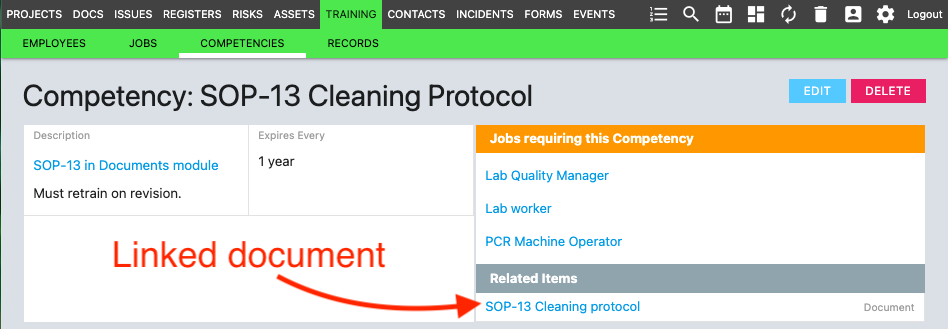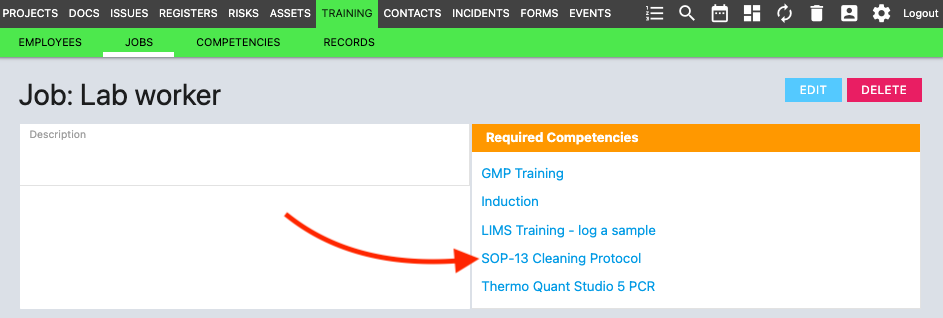How to collect "Read and Acknowledge" training records
Clients in highly regulated industries often have to collect training records to show that people have read an important document and acknowledge that they have understood the information. When the document is updated, all the relevant people will need to read and acknowledge understanding again.
These records are typically a simple checkbox completed by the end user.

Most businesses don't allow end users to manage their own training records, so here's how to collect 'Read and acknowledge' style records in QSToolbox.
To set up and manage this process, you will need to be a user in the "training_managers" permission group.
Setup steps
You only need to do these setup steps once.
1. Set up a Competency for your critical document(s)
For each critical document that you need to keep training records for, create a competency to match in the training module, and link them together as related items. (You can link multiple documents to a single competency, but there are caveats - see below).

2. Set up 'Jobs' with required competencies, including for any relevant critical documents.
For each role in the business that must read and acknowledge the document, select it as a required competency for the Job. This is how QSToolbox will identify employees with missing training records.

3. Allocate Job(s) to Employees
Assign the job to relevant employees. Employees pick up competency requirements though their Job(s). You can also assign a Job to multiple employees at once using 'Bulk Actions'.
Collecting acknowlegments.
For this function to work correctly your employees will also need to be users in your QSToolbox site so that they can tick off their Tasks. QSToolbox uses the email address to match users to employees, so also make sure the email is entered for each employee.
Employees and Users are separate things in QSToolbox. 'Employees' are the people listed in the Training module who you want to track training requirements and records for. 'Users' are the people who can login.
1. On the Competency view, click the "add Tasks" button to assign a task to relevant employees.
The competency view shows all the people who have current training records, and all the people who still require records for that competency.
When you click the "Add Tasks" button, Toolbox will pre-select the matching users for all the employees listed under the Training Gap and open up the new task window.

(The "Add records" button lets you create multiple training records directly. You might use this for employees who aren't users in QSToolbox and you've collected their acknowledgement on paper.)
In the task window, enter a task name and any other information you want to include. When you click 'save task' QSToolbox will create duplicate tasks - one assigned to each user. You can see the list of tasks on the 'Tasks' tab for the competency.

2. Users tick off the "I have read and understood" task
Users will see the new "I have read and understood" task on their Work List and can easily mark it as done to confirm their understanding. You'll be able to see status of these tasks in QSToolbox and users will continue to receive reminders until they've completed the task.

3. Convert the completed tasks into Training records.
Go to the Tasks tab and filter the tasks to only show completed ones. Click the link "Add training records for completed" to convert these tasks into Training records, adding notes and attachments as needed.

You should see these records appear on the 'current records' side of the competency view.
When the document is updated and re-training is required.
For significant changes, you'll want to invalidate all the training records from the previous version of the document and create new training records for the new version.
1. Expire all current Training records
Follow the related items link from the document to the competency and look for the "EXPIRE ALL" button. This will invalidate all current records by setting the expiry date to yesterday.
If you don't want to expire them all or want to select a different expiry date, use the "LIST RECORDS" button to see these records in the Training Records view and then use 'Bulk Actions' to expire selected records.

2. Clear out old tasks
Go to the competency 'Tasks' tab and use the Shortcuts link to "Delete all' or "Delete filtered" depending on how you've filtered the tasks.

3. Follow the steps above for collecting acknowledgements.
FAQ.
Can I link multiple documents to a single competency?
Yes you can, but it has to make sense for them to always be handled as a group. This generally means that the training (and any re-training) for all the linked documents is done at the same time. You can't track acknowledgement for updates of individual documents grouped this way.
